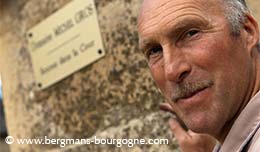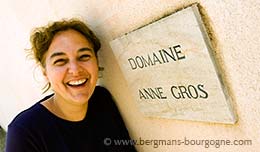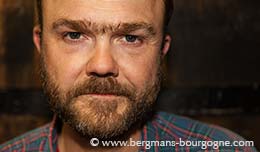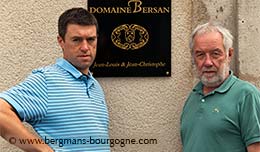
omaine Bonneau du Martray has a history that goes way back, but it was only in the early 1970's that the domaine began to bottle its own wine. Since then Bonneau du Martray has become synonymous with Corton-Charlemagne. Since 1994 Jean-Charles le Bault de la Morinière has been fine-tuning the estate that his father brought back to life. Vintage character and continuity are two words he often comes back to.
– In recent years, since 2003 I think that the vintage character speaks louder than ever, he says. Each vintage reflects something. Personally I find it positive. It is never exactly the same wine. There is some continuity, but each vintage brings a certain nuance that provides great pleasure.
This is a domaine that only has grand cru land and all is up on the Corton hill. The main part is the Corton-Charlemagne, 9.5 hectares in total. In addition to this there is a small production of red Corton, 1.5 hectares that at best produce 6000 bottles annually.
Jean-Charles le Bault de la Morinière is standing at the very top of the slope opposite the Corton hill. He has brought me here because this is where you get the best view over the domaine's holdings that occupy a broad band across the hill, from the Aloxe-Corton side to the Pernand-Vergelesses side. All eleven hectares are one single piece of land, something highly unusual in the otherwise so fragmented world of Burgundy.

– When my father took over from my great-uncle the situation was not particularly good, explains Jean-Charles le Bault de la Morinière. Half of the domaine was let to neighbours, on métayage, and the domaine's production was very limited.
What was kept at the domaine was very often sold off in casks to négociants. Very little was bottled for the domaine, so economically it couldn't work.
– So my parents decided to take back their vineyards. It was not easy, because when the négociants have been used to getting such big quantities of Corton-Charlemagne they are not happy when the vigneron starts to bottle himself.
The winery of Domaine Bonneau du Martray is located in the middle of Pernand-Vergelesses, just above the church. The mansions courtyard is no more; it is now all part of the winery.
When back in the vast cellars of the domaine Jean-Charles le Bault de la Morinière opens a bottle of 1994 Corton-Charlemagne.
– 1994 doesn't have a high reputation in Burgundy, he says. But after all it has been extremely satisfactory, especially in Corton-Charlemagne. The winemaking was very easy. This vintage has always been approachable and friendly. It never closed down. It is perhaps not as sharp and steely as a classic vintage like 1993; it is more up-front.
It was in 1994 that Jean-Charles le Bault de la Morinière took over from his father. By then he had been practising as an architect in Paris for two decades and was not at all sure that he wanted to uproot his family and move to Burgundy.

– When you are in your mid-40's you have family, children, he says. So it was an important decision. I had to move here; I couldn't run the domaine living elsewhere. One has to think about the children and their education. Things like that. So for some time my wife and children stayed in Paris.
While discussing this he pulls the cork from a 1999 Corton-Charlemagne.
– The 1999 vintage was blessed with both quality and quantity. Today the 1994 shows a little milder, something that has to do both with vintage character and age. The 1999 has a different vintage character. It is more intense, more powerful and also sharper.
But despite these differences there are similarities, the continuity that Jean-Charles le Bault de la Morinière talks about.
– I would say that our vineyard provides a wine which is always showing restrained power, very clear minerality and that has this backbone that is almost like a razorblade. These are characteristics that we find in each vintage. It's a combination of power and concentration, but also understatement, always on the mineral side. Even in a vintage like 2003, which is a totally odd vintage, the wine shows this minerality. Not as sharp of course as in other vintages, but it's there. This creates the continuity.

After this he pours a 2003 Corton-Charlemagne to illustrate his thoughts. He describes it as a wine with a dense texture, a wine that is very powerful. His prediction is that it should age very gracefully and that it will require spicier, richer food.
– When we bottled the wine I went into Beaune and bought slices of old Parmigiano-Reggiano. It matched perfectly.
Today Domaine Bonneau du Martray sells 80 per cent of its annual production on the export market. When domaine bottling began in the 1970's they were quick to start exporting. First to the neighbouring markets in Belgium, Luxembourg, the Netherlands and Switzerland. Then the US and the UK quickly became the main markets.
The domaine is one of the largest when it comes to owning Corton-Charlemagne land. While Domaine Bonneau du Martray has 9.5 hectares of these precious vines most of the other winegrowers have one hectare or less.
– In terms of style there are some strong differences between the producers of Corton-Charlemagne, says Jean-Charles le Bault de la Morinière. In essence these differences are created by the different positions – if the vines are facing south, southeast, northwest or plain west as ours are. There are also some differences in soil, which also affects the wine. Then you have the touch of each grower making the wine. All this creates differences. I'm not here to explain the work of my colleagues. I know who is able to make a bottle of Corton-Charlemagne which, in a way, is not too different from mine. But I also know other Corton-Charlemagnes which are almost the opposite.

In the cellar the 2006 Corton-Charlemagne is next. This is a wine that he says he was even happier with than the 2005.
– I remember we had a long and cold winter. It was very much snow; up to my knees in March. Then followed a good spring and a nice summer.
– What I like about this vintage is that everything is in its place. There is a perfect integration of all the ingredients. It's a vintage with great unity, which doesn't always happen. Sometimes it comes with age. Here it's there from the beginning.
The last Corton-Charlemagne of the day is the 2007, a wine Jean-Charles le Bault de la Morinière describes as having completely different shape. While the 2006 is round, almost egg-shaped, the 2007 has more of a linear shape.
– The first perception is of ripe white fruit, he says. But immediately afterwards I can feel this mineral backbone, which for me is steely and sharp. I believe this vintage has an extremely long finish, carried by the minerals, something that is sharp, something which is almost salty on the edges. I find it sharper than the 2006. They really are different.
© 2010 Ola Bergman














